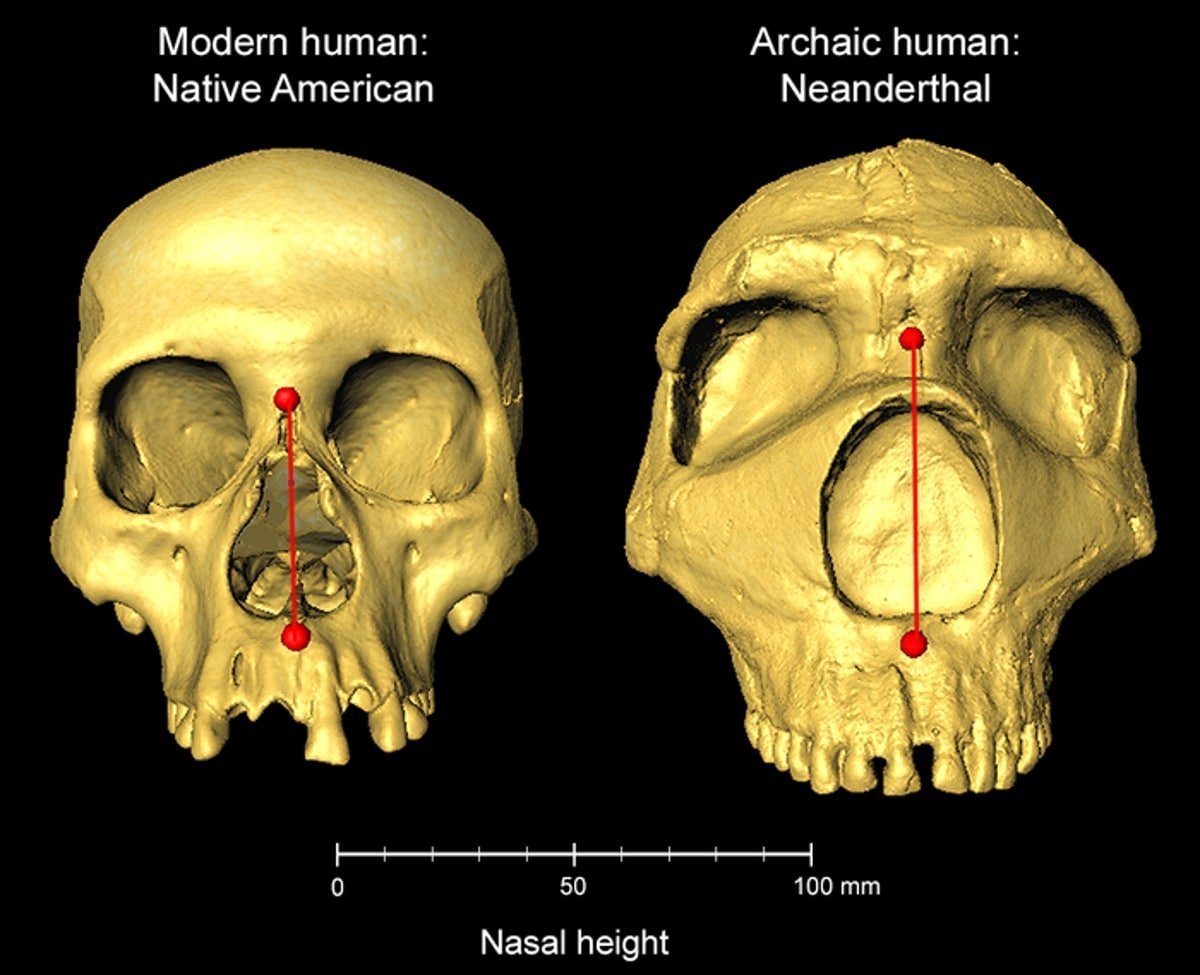
summary: A particular gene inherited from Neanderthals may be responsible for the shape of our noses.
The study suggests that the shape of our noses may have evolved through natural selection in response to the different climates and environments our ancestors encountered as they migrated around the world.
The research highlights the importance of understanding the genetic diversity of different populations to better understand the evolution of human traits.
Key facts:
- Researchers used data from more than 6,000 volunteers from across Latin America, of mixed European, Native American, and African ancestry, to study the genetic influence on facial features.
- They identified 33 genome regions associated with facial shape, 26 of which they were able to replicate in comparisons with data from other races using East Asian, European or African participants.
- In a particular region of the genome called ATF3, several people in the study of Native American ancestry had genetic material in this gene inherited from Neanderthals, which contributes to a higher nose height. This genetic region has signs of natural selection, suggesting that it confers an advantage on those who carry the genetic material.
source: UCL
A new study led by UCLA researchers finds that humans inherited genetic material from Neanderthals that affects the shape of our noses.
the new Communication biology The study found that a particular gene, which leads to a longer (top to bottom) nose, may have been a product of natural selection as ancient humans adapted to colder climates after leaving Africa.
Interview co-author Dr Kaustuph Adhikari (Genetics, Evolution, Ecology and The Open University at UCLA) said: “In the last 15 years, since sequencing the Neanderthal genome, we have been able to learn that our ancestors apparently interbred with Neanderthals., Which leaves us with little bits of their DNA.

“Here, we find that some DNA inherited from Neanderthals influences the shape of our faces. This would have been beneficial to our ancestors, as it has been passed down for thousands of generations.”
The study used data from more than 6,000 volunteers from across Latin America, of mixed European, Native American and African ancestry, who are part of the UCL-led CANDELA study, which recruited from Brazil, Colombia, Chile, Mexico and Peru.
The researchers compared the genetic information from the participants with pictures of their faces — specifically by looking at the distances between points on their faces, such as the tip of the nose or the edge of the lips — to see how different facial features were associated with having different genetic markers.
The researchers recently identified 33 genome regions associated with facial shape, 26 of which they were able to replicate in comparisons with data from other races using East Asian, European or African participants.
In one region of the genome in particular, called ATF3the researchers found that several people in their study of Native American ancestry (as well as others of East Asian ancestry from another group) had genetic material in this gene inherited from Neanderthals, which contributes to a taller nose.
They also found that this genetic region had signs of natural selection, suggesting that it conferred an advantage on those who carried the genetic material.
First author Dr Cheng Li (Fudan University) said: “It has long been speculated that the shape of our noses is determined by natural selection. Because our noses can help us regulate the temperature and humidity of the air we breathe, noses with different shapes may be better suited to different climates.” in which our ancestors lived.
“The gene we identify here may have been inherited from Neanderthals to help humans adapt to colder climates as our ancestors moved out of Africa.”
Co-author Professor Andrés Ruiz Linares (University of Fudan, UCLA Genetics, Evolution and Ecology, Aix-Marseille University) added: “Most genetic studies of human variation have looked at the genes of Europeans. The diverse sample in our study expanded from Latin American participants from The range of genetic study results, helping us to better understand the genes of all humans.”
This discovery is the second discovery of DNA from ancient humans, different from Homo sapiens, affecting the shape of our face. In a 2021 paper, the same team discovered that a gene that affects lip shape was inherited from ancient Denisovans.
The study included researchers based in the UK, China, France, Argentina, Chile, Peru, Colombia, Mexico, Germany and Brazil.
author: Chris Lane
source: UCL
communication: Chris Lane – UCL
picture: Image credit to Dr Kaustubh Adhikari, UCL
Original search: open access.
“Automated landmarks identify novel sites associated with facial morphology and implicate Neanderthal entry into human nasal shapeWritten by Kaustubh Adhikari et al. Communication biology
a summary
Automated landmarks identify novel sites associated with facial morphology and implicate Neanderthal entry into human nasal shape
We report a genome-wide association study of facial features in over 6,000 Latin Americans based on automatic feature identification of 2D images and testing of association with distances between landmarks. We detected significant correlations (P-value < 5 × 10−8) in 42 genome regions, nine of which were previously reported.
In follow-up analyses, 26 of the 33 new regions of East Asians, Europeans, or Africans are duplicated, and a homologous region of mice affects craniofacial morphology in mice.
The new region on 1q32.3 shows introversion from Neanderthals and we find that the advancing tract increases nasal height (consistent with differentiation between Neanderthals and modern humans).
Novel regions include candidate genes and genome regulatory elements previously implicated in craniofacial development, and show preferential transcription in cranial neural crest cells.
The automated approach used here should simplify the collection of large study samples from around the world, facilitating global characterization of the genetics of facial features.

“Web maven. Infuriatingly humble beer geek. Bacon fanatic. Typical creator. Music expert.”





More Stories
Scientists confirm that monkeys do not have time to write Shakespeare: ScienceAlert
SpaceX launches 23 Starlink satellites from Florida (video and photos)
A new 3D map reveals strange, glowing filaments surrounding the supernova